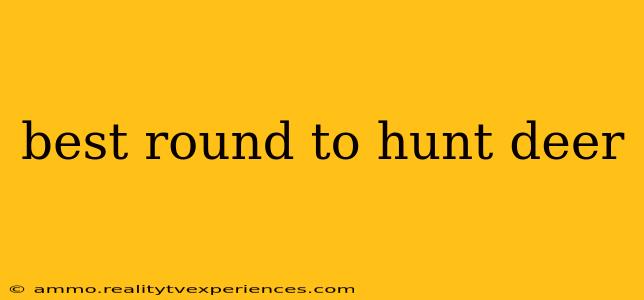Deer hunting is a cherished tradition for many, a thrilling pursuit demanding patience, skill, and a keen understanding of deer behavior. Timing is everything in deer hunting, and choosing the right time of year significantly impacts your success rate. This comprehensive guide explores the best rounds (periods) for hunting deer, considering various factors like deer activity, weather conditions, and hunting regulations.
Understanding Deer Behavior Throughout the Year
Before diving into specific hunting rounds, it's crucial to understand the seasonal patterns influencing deer behavior. These patterns largely dictate the best times to hunt.
Spring: A Time of Renewal, but Not Peak Hunting
Spring marks the end of the rut (breeding season) and the beginning of new life. Does are focused on raising fawns, making them less predictable and more cautious. Hunting success in spring is generally lower than during other seasons. While some areas may allow spring hunting, it's often limited and regulated.
Summer: A Period of Growth and Preparation
Summer is a period of growth and preparation for the upcoming rut. Deer are less active during the hottest parts of the day, seeking shade and conserving energy. Hunting during the cooler morning and evening hours offers the best chances of success. This period might be considered by some a less ideal time to hunt due to the dense foliage.
Fall: The Prime Time for Deer Hunting
Fall is arguably the best time for deer hunting, offering two distinct peak periods:
Early Fall (Pre-Rut):
- Increased Activity: As the weather cools, deer become more active, feeding intensely to build up fat reserves for the upcoming winter.
- Predictable Patterns: Their feeding patterns become more predictable, making them easier to locate and hunt.
- Optimal Weather: Generally, the weather is still pleasant, making for comfortable hunting conditions.
The Rut (Breeding Season):
- Peak Activity: The rut is characterized by highly erratic and unpredictable deer movements. Bucks are actively searching for does, often ignoring caution in their pursuit. This heightened activity significantly increases hunting success rates.
- Aggressive Bucks: Bucks become more aggressive and less wary during the rut, providing excellent hunting opportunities.
- Variable Timing: The exact timing of the rut varies depending on geographic location and altitude. Research your specific hunting area to determine the peak rutting period.
Late Fall/Winter: A Time of Survival
As winter approaches, deer activity decreases due to colder temperatures and reduced food sources. However, deer are forced to concentrate near available food and water sources, making them easier to locate. Tracking and still hunting become particularly effective during this period. This is often a better time for hunting in areas with heavy snowfall, as deer tracks become more visible.
Factors to Consider When Choosing Your Hunting Round
Besides the deer's seasonal behavior, several other factors should influence your decision:
- Hunting Regulations: Check your state's hunting regulations carefully. Specific hunting seasons, bag limits, and weapon restrictions vary widely.
- Weather Conditions: Extreme weather can significantly impact deer activity and hunter success. Wind, rain, and snow can affect deer movement and scent dispersal.
- Hunting Location: The terrain, vegetation, and deer population density will all influence your hunting strategy and the best time to hunt.
- Personal Preferences: Consider your hunting style and preferred hunting methods when choosing the best round for you.
Conclusion: Strategic Timing is Key to Success
Choosing the best round to hunt deer requires careful consideration of multiple factors. While fall, particularly during the pre-rut and rut periods, offers the best overall chances of success, understanding deer behavior throughout the year can lead to opportunities in other seasons as well. Thorough research, adherence to hunting regulations, and adaptation to changing conditions are all crucial to maximizing your chances of a successful hunt. Remember to always practice safe and ethical hunting practices.

